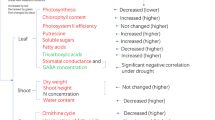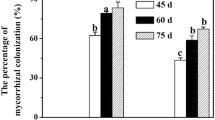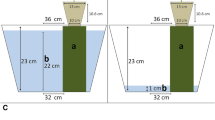Abstract
The combined effects of arbuscular mycorrhizal fungi (AMF) and low temperature (LT) on cucumber plants were investigated with respect to biomass production, H2O2 accumulation, NADPH oxidase, ATPase activity and related gene expression. Mycorrhizal colonization ratio was gradually increased after AMF-inoculation. However, LT significantly decreased mycorrhizal colonization ability and mycorrhizal dependency. Regardless of temperature, the total fresh and dry mass, and root activity of AMF-inoculated plants were significantly higher than that of the non-AMF control. The H2O2 accumulation in AMF-inoculated roots was decreased by 42.44 % compared with the control under LT. H2O2 predominantly accumulated on the cell walls of apoplast but was hardly detectable in the cytosol or organelles of roots. Again, NADPH oxidase activity involved in H2O2 production was significantly reduced by AMF inoculation under LT. AMF-inoculation remarkably increased the activities of P-type H+-ATPase, P-Ca2+-ATPase, V-type H+-ATPase, total ATPase activity, ATP concentration and plasma membrane protein content in the roots under LT. Additionally, ATP concentration and expression of plasma membrane ATPase genes were increased by AMF-inoculation. These results indicate that NADPH oxidase and ATPase might play an important role in AMF-mediated tolerance to chilling stress, thereby maintaining a lower H2O2 accumulation in the roots of cucumber.



Similar content being viewed by others
References
Abdel Latef AAH, He CX (2011) Arbuscular mycorrhizal influence on growth, photosynthetic pigments, osmotic adjustment and oxidative stress in tomato plants subjected to low temperature stress. Acta Physiol Plant 33:1217–1225
Ahn S, Im Y, Chung G, Seong K, Cho B (2000) Sensitivity of plasma membrane H+-ATPase of cucumber root system in response to low root temperature. Plant Cell Rep 19:831–835
Airaki M, Leterrier M, Mateos RM, Valderrama R, Chaki M, Barroso JB, Del Río L, Palma JM, Corpas FJ (2012) Metabolism of reactive oxygen species and reactive nitrogen species in pepper (Capsicum annuum L.) plants under low temperature stress. Plant Cell Environ 35:281–295
Bago B, Donaire JP, Azcón-Aguilar C (1997) ATPases activities of root from mycorrhizal sunflower (Helianthus annuus) and onion (Allium cepa) plants. New Phytol 136:305–311
Baon JB, Smith SE, Alston AM (1994) Phosphorus uptake and growth of barley as affected by soil temperature and mycorrhizal infection. J Plant Nutr 17:479–491
Benabdellah K, Azcón-Aguilar C, Ferrol N (1999) Plasma membrane ATPase and H+ transport activities in microsomal membranes from mycorrhizal tomato roots. J Exp Bot 50:1343–1349
Bestwick CS, Brown I, Bennett MHR, Mansfield JW (1997) Localization of hydrogen peroxide accumulation during the hypersensitive reaction of lettuce cells to Pseudomonas syringae pv phaseolicola. Plant Cell 9:209–221
Bradford MM (1976) A rapid and sensitive method for the quantitation of microgram quantities of protein utilizing the principle of protein–dye binding. Anal Biochem 72:248–254
Bunn R, Lekberg Y, Zabinski C (2009) Arbuscular mycorrhizal fungi ameliorate temperature stress in thermophilic plants. Ecology 90:1378–1388
Charest C, Dalp Y, Brown A (1993) The effect of vesicular arbuscular mycorrhizae and chilling on two hybrids of Zea mays L. Mycorrhiza 4:89–92
Cheeseman JM (2007) Hydrogen peroxide and plant stress: a challenging relationship. Plant Stress 1:4–15
Chen SC, Jin WJ, Liu AR, Zhang SJ, Liu DL, He CX (2013) Arbuscular mycorrhizal fungi (AMF) increase growth and secondary metabolism in cucumber subjected to low temperature stress. Sci Hortic 160:222–229
Dietz KJ, Tavakoli N, Kluge C, Mimura T, Sharma SS, Harris GC, Chardonnens AN, Golldack D (2001) Significance of the V-type ATPase for the adaptation to stressful growth conditions and its regulation on the molecular and biochemical level. J Exp Bot 52:1969–1980
Doulis AG, Debian N, Kingston-Smith AH, Foyer CH (1997) Differential localization of antioxidants in maize leaves. Plant Physiol 114:1031–1037
El-Tohamy W, Schnitzler WH, El-Behairy U, El-Beltagy MS (1999) Effect of VA mycorrhiza on improving drought and chilling tolerance of bean plants (Phaseolus vulgaris L.). J Appl Bot 73:178–183
Ferrol N, Pozo MJ, Antelo M, Azcón-Aguilar C (2002) Arbuscular mycorrhizal symbiosis regulates plasma membrane H+-ATPase gene expression in tomato plants. J Exp Bot 53:1683–1687
Fester T, Hause G (2005) Accumulation of reactive oxygen species in arbuscular mycorrhizal roots. Mycorrhiza 15:373–379
Garg N, Bhandari P (2012) Influence of cadmium stress and arbuscular mycorrhizal fungi on nodule senescence in Cajanus cajan (L.) Millsp. Int J Phytorem 14:62–74
Garg N, Kaur H (2013) Response of antioxidant enzymes, phytochelatins and glutathione production towards Cd and Zn stresses in Cajanus cajan (L.) Millsp genotypes colonized by arbuscular mycorrhizal fungi. J Agron Crop Sci 199:118–133
Gavito ME, Azcon-Aguilar C (2012) Temperature stress in arbuscular mycorrhizal fungi: a test for adaptation to soil temperature in three isolates of Funneliformis mosseae from different climates. Agric Food Sci 21:2–11
Gianinazzi-Pearson V, Gollotte A, Tisserant B, Franken P, Dumas-Gaudot E, Lemoine MC, van Tuinen D, Gianinazzi S, Lherminier J (1995) Cellular and molecular approaches in the characterization of symbiotic events in functional arbuscular mycorrhizal associations. Can J Bot 73:526–532
Gianinazzi-Pearson V, Arnould C, Oufattole M, Arango M, Gianinazzi S (2000) Differential activation of H+-ATPase genes by an arbuscular mycorrhizal fungus in root cells of transgenic tobacco. Planta 211:609–613
Giovannetti M, Mosse B (1980) An evaluation of techniques for measuring vesicular–arbuscular infection in roots. New Phytol 84:489–500
Graham JH (2000) Assessing costs of arbuscular mycorrhizal symbiosis agroecosystems fungi. In: Podila GK, Douds DD Jr (eds) Current advances in mycorrhizae research. APS Press, St. Paul, pp 127–140
Hajiboland R, Aliasgharzadeh N, Laiegh SF, Poschenrieder C (2010) Colonization with arbuscular mycorrhizal fungi improves salinity tolerance of tomato (Solanum lycopersicum L.) plants. Plant Soil 331:313–327
Hayman DS (1974) Plant growth responses to vesicular-arbuscular mycorrhiza. VI. Effect of light and temperature. New Phytol 73:71–80
He X, Xu M, Qiu GY, Zhou J (2009) Use of stable 15N isotope to quantify nitrogen transfer between mycorrhizal plants. J Plant Ecol 2:107–118
Huang LL, Yang C, Zhao Y, Xu X, Xu Q, Li GZ, Cao J, Herbert SJ, Hao L (2008) Antioxidant defenses of mycorrhizal fungus infection against SO2-induced oxidative stress in Avena nuda seedlings. Bull Environ Contam Toxicol 81:440–444
Huda KMK, Banu MSA, Tuteja R, Tuteja N (2013) Global calcium transducer P-type Ca2+-ATPases open new avenues for agriculture by regulating stress signalling. J Exp Bot 64(11):3099–3109
Janicka-Russak M, Kabała K, Wdowikowska A, Kłobus G (2012) Response of plasma membrane H+-ATPase to low temperature in cucumber roots. J Plant Res 125:291–300
Jeter CR, Tang W, Henaff E, Butterfield T, Roux SJ (2004) Evidence of a novel cell signaling role for extracellular adenosine triphosphates and diphosphates in Arabidopsis. Plant Cell 16:2652–2664
Kasamo K (2003) Regulation of plasma membrane H+-ATPase activity by the membrane environment. J Plant Res 116:517–523
Kim HS, Oh JM, Luan S, Carlson JE, Ahn SJ (2013) Cold stress causes rapid but differential changes in properties of plasma membrane H+-ATPase of camelina and rapeseed. J Plant Physiol 170:828–837
Kormanik PP, Bryan WC, Schultz RC (1980) Procedure and equipment for staining large number of plant roots for endomycorrhizal assay. Can J Microbiol 26:536–538
Krajinski F, Hause B, Gianinazzi-Pearson V, Franken P (2002) Mtha1, a plasma membrane H+-ATPase gene from Medicago truncatula, shows arbuscule-specific induced expression in mycorrhizal tissue. Plant Biol 4:754–761
Li BQ, Zhang CF, Cao BH, Qin GZ, Wang WH, Tian SP (2012) Brassinolide enhances cold stress tolerance of fruit by regulating plasma membrane proteins and lipids. Amino Acids 43:2469–2480
Lin H, Wu L (1996) Effects of salt stress on root plasma membrane characteristics of salt-tolerant and salt-sensitive buffalograss clones. Environ Exp Bot 36:239–247
Liu A, Wang B, Hamel C (2004) Arbuscular mycorrhiza colonization and development at suboptimal root zone temperature. Mycorrhiza 14:93–101
Liu YP, Zhang JH, Liu HT, Huang WD (2008) Salicylic acid or heat acclimation pre-treatment enhances the plasma membrane-associated ATPase activities in young grape plants under heat shock. Sci Hortic 119:21–27
Liu AR, Chen SC, Liu YY, Li YN, He CX (2011) Effect of AM fungi on leaf photosynthetic physiological parameters and antioxidant activities under low temperature. Acta Ecol Sinica 31:3497–3503
Livak KJ, Schmittgen TD (2001) Analysis of relative gene expression data using real-time quantitative PCR and the 2−∆∆CT method. Methods 25:402–408
Marino D, Dunand C, Puppo A, Pauly N (2012) A burst of plant NADPH oxidases. Trends Plant Sci 17:9–15
Ohnishi T, Gall RS, Mayer ML (1975) An improved assay of inorganic phosphate in the presence of extralabile phosphate compounds: application to the ATPase assay in the presence of phosphocreatine. Anal Biochem 69:261–267
Piotrovskii MS, Shevyreva TA, Zhestkova IM, Trofimova MS (2011) Activation of plasmalemmal NADPH oxidase in etiolated maize seedlings exposed to chilling temperatures. Russ J Plant Physl 58:290–298
Porter WM (1979) The “Most Probable Number” method for enumerating infective propagules of vesicular arbuscular mycorrhizal fungi in soil. Aust J Soil Res 17:515–519
Ramos AC, Martins MA, Okorokova-Façanha AL, Olivares FL, Okorokov LA, Sepúlveda N, Façanha AR, Feijó JA (2009) Arbuscular mycorrhizal fungi induce differential activation of the plasma membrane and vacuolar H+ pumps in maize roots. Mycorrhiza 19:69–80
Ratajczak R, Richter J, Lüttge U (1994) Adaptation of the tonoplast V-type H+-ATPase of Mesembryanthemum crystallinum to salt stress, C3-CAM transition and plant age. Plant Cell Environ 17:1101–1112
Rosewarne GM, Smith AF, Schachtman DP, Smith SE (2007) Localization of proton-ATPase genes expressed in arbuscular mycorrhizal tomato plants. Mycorrhiza 17:249–258
Ruiz-Sáncheza M, Aroca R, Muñoz Y, Polón R, Ruiz-Lozano JM (2010) The arbuscular mycorrhizal symbiosis enhances the photosynthetic efficiency and the antioxidative response of rice plants subjected to drought stress. J Plant Physiol 167:862–869
Sagi M, Fluhr R (2001) Superoxide production by plant homologues of the gp91phox NADPH oxidase. Modulation of activity by calcium and by tobacco mosaic virus infection. Plant Physiol 126:1281–1290
Smith SE, Bowen GD (1979) Soil temperature, mycorrhizal infection and nodulation of Medicago truncatula and Trifolium subterraneum. Soil Biol Biochem 11:469–473
Smith SE, Smith FA (1990) Structure and function of the interfaces in biotrophic symbioses as they relate to nutrient transport. New Phytol 114:1–38
Song CJ, Steinebrunner I, Wang XZ, Stout SC, Roux SJ (2006) Extracellular ATP induces the accumulation of superoxide via NADPH oxidases in Arabidopsis. Plant Physiol 140:1222–1232
Vignais PV (2002) The superoxide-generating NADPH oxidase: structural aspects and activation mechanism. Cell Mol Life Sci 59:1428–1459
Volkmar KM, Woodbury W (1989) Effects of soil temperatures and depth on colonization and root and shoot growth of barley inoculated with vesicular-arbuscular mycorrhizae indigenous to Canadian prairie soil. Can J Bot 67:1702–1707
Wang YZ, Sze H (1985) Similarities and differences between the tonoplast-type and mitochondrial H+-ATPase of oat roots. J Bio Chem 260:10434–10443
Willekens H, Chamnongpol S, Davey M, Schraudner M, Langebartels C, Van Montagu M, Inzé D, Van Camp W (1997) Catalase is a sink for H2O2 and is indispensable for stress defence in C3 plants. EMBO J 16:4806–4816
Wu QS, Zou YN (2010) Beneficial roles of arbuscular mycorrhizas in citrus seedlings at temperature stress. Sci Hortic 125:289–293
Zhang RQ, Zhu HH, Zhao HQ, Yao Q (2013) Arbuscular mycorrhizal fungal inoculation increases phenolic synthesis in clover roots via hydrogen peroxide, salicylic acid and nitric oxide signaling pathways. J Plant Physiol 170:74–79
Zhou J, Wang J, Shi K, Xia XJ, Zhou YH, Yu JQ (2012a) Hydrogen peroxide is involved in the cold acclimation-induced chilling tolerance of tomato plants. Plant Physiol Biochem 60:141–149
Zhou ZZ, Ma HM, Liang KN, Huang GH, Pinyopusarerk K (2012b) Improved tolerance of teak (Tectona grandis L.f.) seedlings to low-temperature stress by the combined effect of arbuscular mycorrhiza and paclobutrazol. J Plant Growth Regul 31:427–435
Zhu XC, Song FB, Xu HW (2010) Influence of arbuscular mycorrhiza on lipid peroxidation and antioxidant enzyme activity of maize plants under temperature stress. Mycorrhiza 20:325–333
Acknowledgments
This work was supported by National Natural Science Foundation of China (31101536), National Key Technology R&D Program of China (2011BAD12B03), Science Development Plan Project of Shandong Province (2012GNC011111), Outstanding Young Teacher Project in Henan Province (2011GGJS-075, 2012GGJS-078) and the National Scholar Foundation for Studying Abroad (2011841011, 2011841012).
Author information
Authors and Affiliations
Corresponding author
Rights and permissions
About this article
Cite this article
Liu, A., Chen, S., Chang, R. et al. Arbuscular mycorrhizae improve low temperature tolerance in cucumber via alterations in H2O2 accumulation and ATPase activity. J Plant Res 127, 775–785 (2014). https://doi.org/10.1007/s10265-014-0657-8
Received:
Accepted:
Published:
Issue Date:
DOI: https://doi.org/10.1007/s10265-014-0657-8




